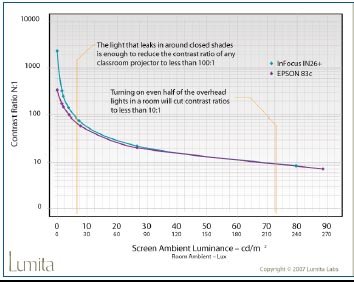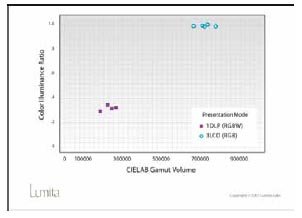articles/Monitors/projectors-page2
Projectors - part 2 of 1 2 3
by Mike McNamee Published 01/04/2009

Brightness
There is a relationship between brightness and cost - more brightness equates to more money as our graph shows. However, there is brightness and brightness out there! Typically brightness is measured and advertised in ANSI lumens and ranges from about 1,200 to 3,500 in 'domestic' systems but can go up to 10,000 for large venue projectors (costing many tens of thousands of pounds). However, the white brightness is false if it is made up of say strong blue and green values, allied with a weak red value. In other words the RGB individual brightnesses distort the colours because of their individual strengths and weaknesses, typically seen as a distortion in the colour gamut, with some parts of the gamut volume heavily clipped. In practice what is seen is a projector with a high claimed brightness producing a significantly duller image than a projector with a more evenly balanced, but lower, headline brightness. As a generalisation, the larger room that you project in, the greater the brightness you need to employ.
As photographers you have to understand one thing - we count for very little in the market place. In the same manner as monitors are targeted at business and gaming users, projectors are targeted at business users and home cinema use. The majority of end-users, and the target market, do not care overmuch about colour reproduction accuracy - that seems to be an exclusive province of photographers!

We count so little that Projector Point categorise their line-up as:
Home Cinema
Office
Education
Ultra Portable
Large Venue
They do have a sub-category called Camera Clubs on their website but they immediately lose brownie points by suggesting that most camera clubs should go for DLP (on the grounds of cost). This is despite the practical experience that the majority of camera club enthusiasts have perfectly good eyes and are as critical as any professional photographer when it comes to viewing digital images. When it comes to colour fidelity, LCD and LCoS win out over DLP by massive and measurable margins.
In order to refine the choices we sorted and assessed the projectors according to the main performance criteria.
Of the 380 projectors looked at, two-thirds were XGA with the remainder being WXGA or a combination of the new HDMI television standards if 720p or 1080p (mainly for the home cinema types).
For photographers the only resolution of interest is XGA at 1024x768. This ratio of 4/3 matches many cameras. WXGA is 1366x768 (a ratio of 1.8:1) and does not match cameras at all, it is the wide-screen standard ratio of 16:9. This is a total waste for photographers as the space either side of the main subject area is redundant, not like a monitor where you can use it to store palettes. The price premium for wasting space by going to this format averages at 37%.
Please Note:
There is more than one page for this Article.
You are currently on page 2 Contact Mike McNamee
1st Published 01/04/2009
last update 21/07/2022 08:46:25
More Monitors Articles
There are 49 days to get ready for The Society of Photographers Convention and Trade Show at The Novotel London West, Hammersmith ...
which starts on Wednesday 14th January 2026










